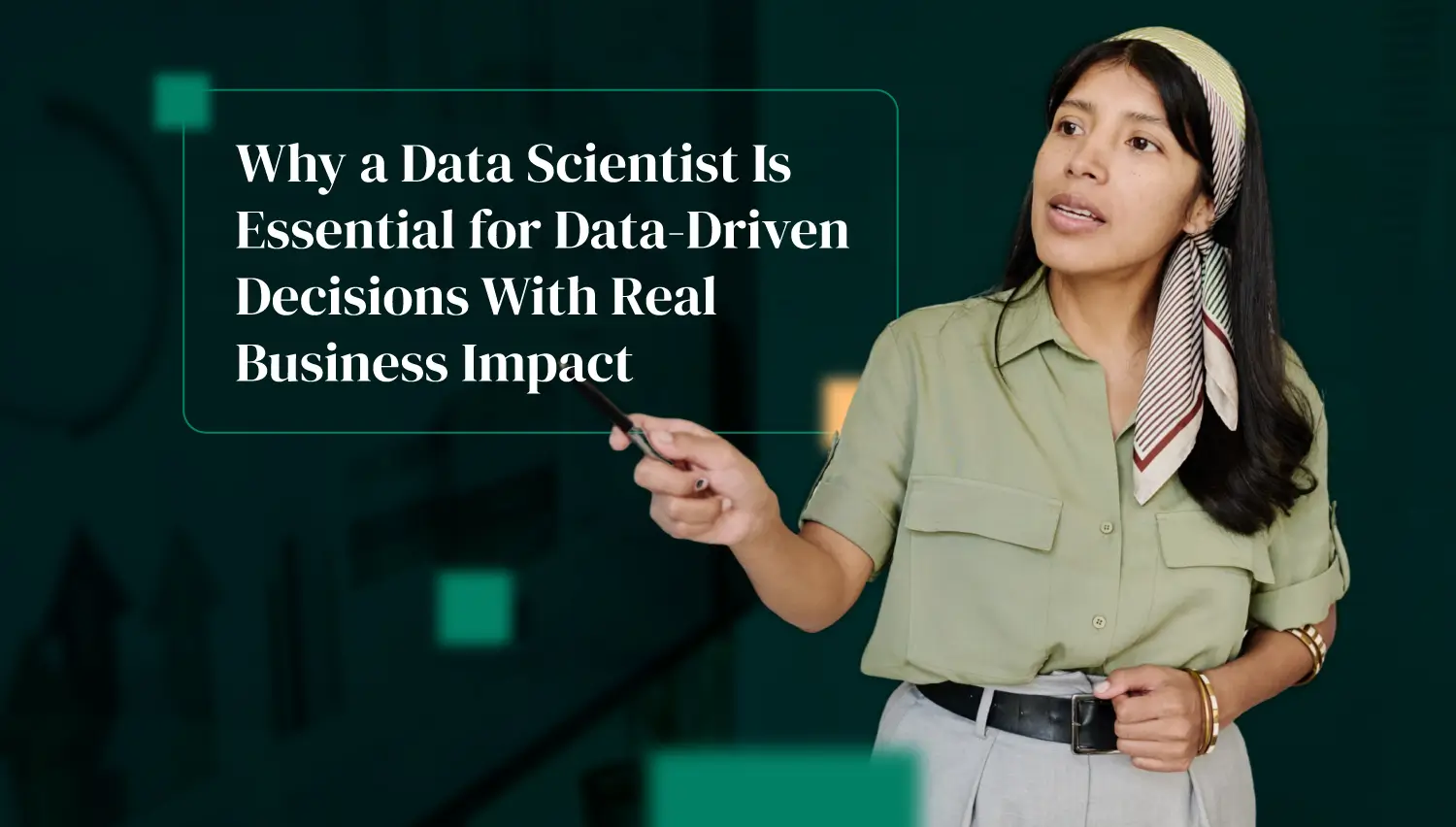I once helped a Series B startup build its first internal data team. They’d scaled fast, their dashboards were immaculate, and analysts were producing reports with surgical precision. But in strategy meetings, decisions still came down to gut instinct. Everyone had data, no one had direction.
It didn’t take long to realize the problem wasn’t visibility; it was interpretation. They didn’t need more charts or dashboards. They needed someone who could translate patterns into strategy.
When we hired their first data scientist, everything shifted. Within weeks, leadership started making faster, sharper calls. Linking customer churn to operational inefficiencies, predicting sales dips before they hit, and investing based on probabilities rather than hunches.
That’s the power of a skilled data scientist: they bridge the gap between technical insight and business action. In a market where precision can determine whether you grow or stall, that bridge between information and impact isn’t a luxury; it’s essential.
The Business Value a Data Scientist Delivers
At its core, a data scientist doesn’t just “work with data.” They make data work for the business.
Where an analyst might explain what happened, a data scientist uncovers why it happened and, more importantly, what to do next. They bridge the space between raw information and strategic action, giving leadership a measurable edge in how they plan, invest, and execute.
Most organizations already have dashboards and reports, but what they lack is synthesis. The ability to connect metrics across departments into a coherent story of performance. Marketing tracks engagement, operations tracks efficiency, and finance tracks runway, but without someone to interpret the relationships between them, those numbers stay siloed.
That’s where a data scientist changes the dynamic. They align information with commercial outcomes, translating patterns into priorities. They see how customer behavior influences churn, how operational bottlenecks affect margins, and how those trends evolve over time.
A strong data scientist operationalizes every data point. They identify which signals truly drive performance, challenge assumptions with evidence, and design predictive models that guide future moves rather than just describe past ones.
In short, they transform static data into motion, turning hindsight into foresight and shifting the organization from reporting to strategy.
.webp)
What a Data Scientist Does Day to Day
A high-performing data scientist’s value becomes clear once you see how their work touches every part of the organization.
Collect and Clean Raw Datasets for Analysis
They design processes to collect, validate, and clean data from multiple systems so analysis is based on truth, not noise. In recruiting for these roles, I always look for candidates who treat data integrity as non-negotiable; if the foundation isn’t solid, everything else collapses.
Identify Trends and Patterns Using Statistical Models
With clean data, the next step is discovery. Data scientists apply statistical modeling to reveal patterns across time, geography, or customer behavior, signals that inform strategic priorities.
Build Predictive Models for Business Decision-Making
The most effective data scientists anticipate what’s coming, not just describe what’s happened. They forecast churn, demand, or pricing trends, giving leadership a forward view of the market.
Analyze Customer Behavior to Improve Targeting
In marketing and product teams, data scientists map how customers move through acquisition funnels and where friction occurs. Those insights sharpen targeting, personalize campaigns, and allocate spend more effectively.
Optimize Operational Processes Through Data Insights
Beyond marketing, they quantify workflow bottlenecks, waste, or resource imbalances, helping streamline systems that directly affect profit margins.
Present Findings in Clear Dashboards or Visualizations
A skilled data scientist doesn’t bury insights in code notebooks; they communicate them. Through clear visualizations and concise reporting, they make analysis actionable for non-technical leaders.
Work with Marketing to Improve Campaign ROI
Partnering with marketing, they test hypotheses on messaging, timing, and audience segmentation, turning creative instincts into data-backed iteration.
Collaborate with Leadership to Identify Data Priorities
The best data scientists don’t wait for a brief; they help define it. They work with executives to pinpoint the questions that truly matter, aligning data priorities with business goals.
Continuously Refine Models for Accuracy and Relevance
Data changes, markets shift, and assumptions age. A mature data scientist revisits and retrains models regularly, ensuring insights remain reliable as the business evolves.
Ensure Data Security and Compliance
Finally, data scientists protect the organization’s credibility by maintaining governance and compliance standards, balancing innovation with responsibility.
Taken together, these capabilities transform how a business sees itself. Instead of reacting to metrics, leaders start making proactive, data-anchored decisions with measurable commercial impact.
Building the Right Data Science Function
Hiring a data scientist isn’t just about adding a technical role. It’s about embedding a new way of thinking. The timing, structure, and integration of that hire all determine how effectively data science will translate into business value.
When to Hire a Data Scientist
In early-stage startups, founders often overestimate how soon they need one. If you’re still defining product-market fit or lack consistent data sources, you may need an analyst first. But once your data volume and complexity exceed what BI tools can manage, it’s time. The telltale sign: you’re sitting on information you can’t interpret.
How to Integrate Them Into Existing Teams
A data scientist should sit close to both technical and strategic decision-makers. The goal is to make data a shared language across functions. When I’ve seen this done well, the data scientist becomes a partner to each department head, not a service desk for ad-hoc requests.
.webp)
Tools and Infrastructure Readiness
Even the most talented hire can’t succeed without a solid data pipeline. Before hiring, assess your infrastructure: Are systems integrated? Are APIs stable? Is data stored cleanly? The ROI of a data scientist rises exponentially when they can analyze rather than troubleshoot.
Aligning Expectations and Outcomes
A data scientist is not a magician. They’re an interpreter of reality. The most successful hires happen when leadership defines what business questions need answering. Setting measurable goals upfront (reducing churn, improving LTV, predicting demand) keeps the role outcome-focused.
Risk Mitigation: Recruiting for Data Science Roles
Bringing on a data scientist can unlock enormous value, but only if the recruitment process matches your organization’s maturity and needs.
Partnering with the Wrong Recruiter
The right recruiter knows how to translate your data goals into a clear hiring brief. They align the search to your business priorities, filter for candidates who can turn data into strategy, and save you from weeks of misaligned interviews.
Hiring Too Broad or Too Narrow
Many job descriptions read like wishlists: deep learning, SQL, marketing analytics, DevOps, and more. The result is a diluted search and mismatched candidates. Define the business problems you want solved, then hire for the skills that map directly to them.
Confusing Analysts, Engineers, and Scientists
In scaling environments, role boundaries blur. Hiring managers should clearly separate data engineering (building pipelines), data analysis (interpreting reports), and data science (predictive modeling and strategy). Overlap is fine; confusion is fatal.
Overlooking Communication Skills
Technical depth means little without clarity. The best data scientists explain complex models in plain language, influence executive decisions, and connect insights directly to business outcomes.
Ignoring Domain Relevance
A data scientist who’s optimized retail demand models may not instantly adapt to SaaS churn. Prioritize candidates who understand your industry’s drivers, or allow onboarding time to bridge that gap.
Overlooking Executive Alignment
The role’s success depends on executive buy-in. If leadership sees them as a reporting function instead of a strategic partner, the value never materializes. Involve decision-makers in interviews and define how data science informs planning cycles.
Turning Insight Into Action
When data science is done right, it changes how a company thinks. Decisions become faster, sharper, and anchored in evidence. But that only happens when you hire intentionally, matching technical expertise with strategic vision.
A skilled data scientist turns information into an advantage. A skilled recruiter makes sure you find that person. Somewhere helps companies identify and hire data scientists who bring measurable business impact from day one.
If you’re ready to turn your data into direction, reach out through the contact form below.













.webp)
.webp)